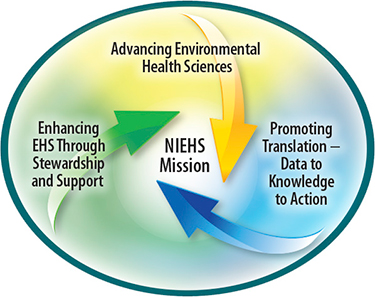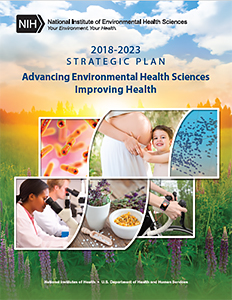Director's Message
NIEHS strives to conduct and support the very best environmental health sciences in alignment with real-world public health needs, and to translate science findings into knowledge that can inform real-life individual and public health outcomes. Success in our mission requires the highest standards of stewardship, and a solid foundation of supportive strategies, resources, and training. The NIEHS strategic plan 2018-2023 comprises three highly interdependent, interactive, and inclusive themes:
- Advancing Environmental Health Sciences
- Promoting Translation – Data to Knowledge to Action
- Enhancing EHS Through Stewardship and Support

During the past five years, our work at the National Institute of Environmental Health Sciences (NIEHS) has been guided by our strategic plan 2012-2017, Advancing Science, Improving Health: A Plan for Environmental Health Research. In constructing that plan, we engaged in a process that was broadly inclusive, to gain the input and expertise of the environmental health sciences (EHS) community and the many other NIEHS stakeholders. The result was a plan that has led not only NIEHS, but the entire field of EHS, to new achievements in knowledge, technologies, approaches, and interventions to address environmental health challenges. But, as some challenges continue – and new ones arise – so must our work.
As we began to map our strategies for the next five years, we again turned to our stakeholder communities and asked for their input through a trends and insights survey conducted online in the summer of 2017. The responses to this survey were both wide-ranging and specific. A recurring theme was the continuing need for many of the priorities articulated in the strategic plan 2012-2017. For example, study of the exposome, which was still in its infancy as a concept in 2012, is now a thriving area of research that is helping to explain the impact of all the environmental exposures of an individual over their lifetime and how they relate to health. Similarly, our understanding of the role of epigenetic processes as mediators of environmental effects has advanced greatly, as has predictive toxicology. The evolution and integration of data science remains crucial to the study of environmental health. So, in considering where we want to lead NIEHS and the field of EHS in the future, we took these goals as our starting point. Our challenge was to set NIEHS research priorities within a rapidly evolving scientific landscape, while ensuring that our science continues to be responsive to meeting the environmental public health needs of people in the U.S. and around the world.
Therefore, this new strategic plan might be considered a version 2.0 of the previous plan – one that incorporates many of its priorities and commitments, with the objective of building on progress made, but also allows for, and enables, innovation and growth in our ability to explore new and ever-more complex problems. Like its predecessor, this plan supports the NIEHS mission to discover how the environment affects people in order to promote healthier lives, as well as our continuing vision to provide global leadership for innovative research that improves public health by preventing disease and disability. It should also be noted that this strategic plan continues to align with the broader goals of the National Institutes of Health (NIH) strategic plan, and provides support to NIH wide and federal interagency priorities and initiatives.
The new strategic plan themes are achieved through focused efforts toward a number of goals. The sections that follow describe, in more detail, our themes and the supporting goals identified for each one. The goals are numbered for convenience – the order in which they are listed does not reflect priority.



